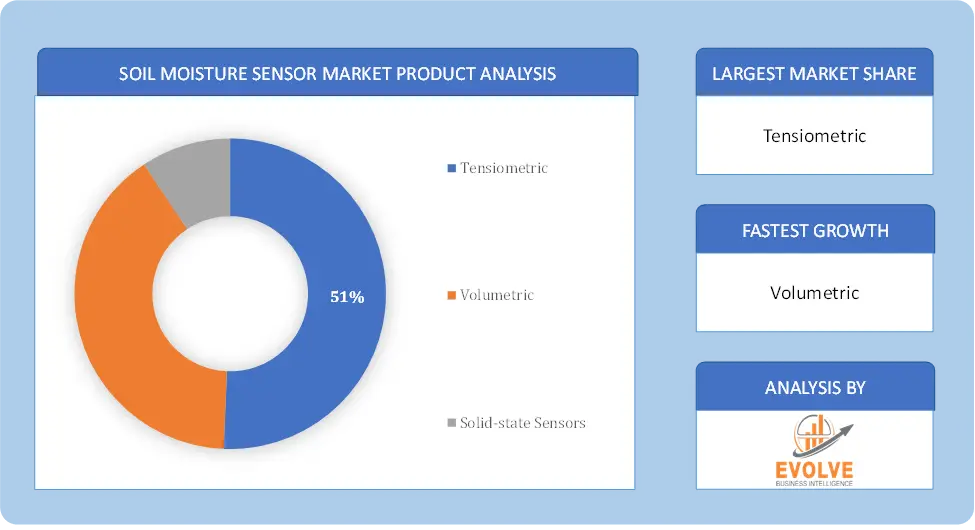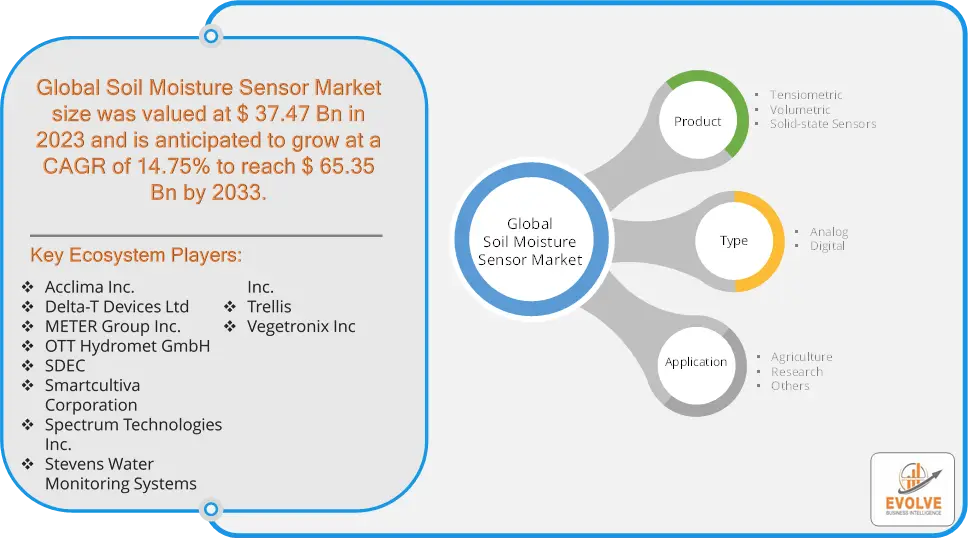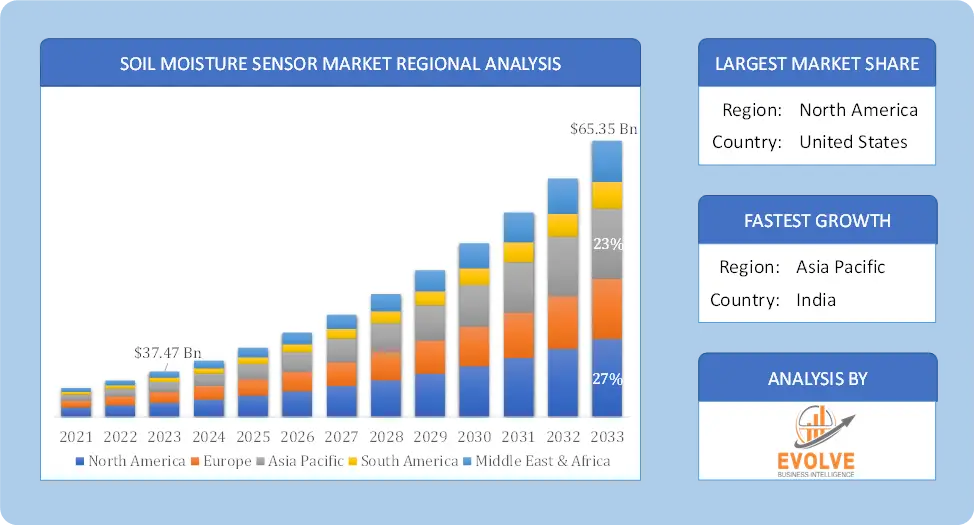Soil Moisture Sensor Market Analysis and Global Forecast 2023-2033
$ 1,390.00 – $ 5,520.00Price range: $ 1,390.00 through $ 5,520.00
Soil Moisture Sensor Market Research Report: Information By Product (Tensiometric, Volumetric, Solid-state Sensors), By Type (Analog, Digital), By Application (Agriculture, Research, Others), and by Region — Forecast till 2033
Page: 174
Soil Moisture Sensor Market Overview
The Soil Moisture Sensor Market Size is expected to reach USD 65.35 Billion by 2033. The Soil Moisture Sensor Market industry size accounted for USD 37.47 Billion in 2023 and is expected to expand at a compound annual growth rate (CAGR) of 14.75% from 2023 to 2033. The Soil Moisture Sensor Market involves the production, distribution, and utilization of sensors designed to measure the moisture content in soil. These sensors are crucial in agriculture, landscaping, and environmental monitoring, as they help optimize water usage by providing real-time data on soil conditions. The market is driven by the increasing need for efficient water management in agriculture, the growing adoption of smart farming techniques, and the rising awareness of the importance of soil health.
The soil moisture sensor market is driven by the increasing demand for precise and efficient monitoring of soil conditions across various sectors.
Global Soil Moisture Sensor Market Synopsis
The COVID-19 pandemic had several impacts on the Soil Moisture Sensor Market. The pandemic caused disruptions in global supply chains, affecting the production and distribution of soil moisture sensors. Lockdowns and restrictions led to delays in the delivery of components and finished products, impacting manufacturers’ ability to meet demand. The focus on health and safety during the pandemic shifted attention away from technological investments in agriculture and environmental monitoring. This shift affected the growth of the soil moisture sensor market in the short term. The pandemic accelerated the adoption of remote monitoring and automation technologies. As remote work and social distancing became prevalent, there was an increased interest in technologies that allow for remote soil moisture monitoring, boosting demand for smart sensors and IoT-enabled solutions. The pandemic spurred innovation as companies sought to adapt to the new normal. This included advancements in sensor technology and the integration of more sophisticated data analytics and IoT capabilities to enhance the efficiency of water usage and agricultural practices.
Soil Moisture Sensor Market Dynamics
The major factors that have impacted the growth of Soil Moisture Sensor Market are as follows:
Drivers:
Ø Advancements in Sensor Technology
Innovations in sensor technology, such as the development of more accurate, durable, and cost-effective sensors, are driving market growth. The integration of sensors with IoT (Internet of Things) technology also enhances their functionality and appeal. The shift towards smart farming, which involves using technology to monitor and manage agricultural processes, is boosting the demand for soil moisture sensors. These sensors play a crucial role in smart irrigation systems and automated farming solutions. The expansion of urban agriculture and landscaping practices in cities is also contributing to market growth. Soil moisture sensors are used in urban gardens, green roofs, and landscaping projects to ensure optimal soil conditions.
Restraint:
- Perception of High Initial Costs and Integration Issues
The upfront investment in soil moisture sensors, particularly advanced models with integrated IoT capabilities, can be high. This cost can be a barrier for small-scale farmers or businesses with limited budgets. Integrating soil moisture sensors with existing irrigation systems and agricultural management software can be complex. Compatibility issues and the need for customized solutions may hinder the widespread adoption of these technologies.
Opportunity
⮚ Integration with Smart Farming Solutions
The increasing adoption of smart farming practices creates opportunities for soil moisture sensors to be integrated into comprehensive agricultural management systems. Combining soil moisture data with other sensors and technologies can enhance farm efficiency and productivity. The integration of soil moisture sensors with advanced data analytics and decision support systems can offer valuable insights for farmers. This can help optimize irrigation practices, improve crop yields, and reduce water consumption. The integration of soil moisture sensors with precision irrigation systems, including smart irrigation controllers and automated systems, offers opportunities for market growth. These solutions provide real-time adjustments based on soil moisture data.
Soil Moisture Sensor Market Segment Overview
By Product
 Based on Product, the market is segmented based on Tensiometric, Volumetric and Solid-state Sensors. The volumetric segment dominant the market. Volumetric soil moisture sensors are designed to measure the water content of the soil directly. Dielectric sensors, heat dissipation sensors, and neutron moisture probes are popular volumetric soil moisture sensors. Volumetric soil moisture sensors are pricey because they use cutting-edge technology to measure the soil’s moisture content. These sensors deliver data quickly and with great accuracy.
Based on Product, the market is segmented based on Tensiometric, Volumetric and Solid-state Sensors. The volumetric segment dominant the market. Volumetric soil moisture sensors are designed to measure the water content of the soil directly. Dielectric sensors, heat dissipation sensors, and neutron moisture probes are popular volumetric soil moisture sensors. Volumetric soil moisture sensors are pricey because they use cutting-edge technology to measure the soil’s moisture content. These sensors deliver data quickly and with great accuracy.
By Type
Based on Type, the market segment has been divided into the Analog and Digital. The digital segment dominant the market. A battery is built into the device to power the screen on digital soil moisture sensors. Like analog soil moisture sensors, these sensors’ probes do not corrode. A tiny electromagnetic pulse is produced by these sensors, which detect moisture. These sensors typically have long cables attached to the probes. The main benefits of using digital soil moisture sensors are how simple it is to get output in digital forms and how little time it takes to interpret and calculate data.
By Application
Based on Application, the market segment has been divided into the Agriculture, Research and Others. The agriculture segment dominant the market. Livestock production, crop production, agricultural economics, and agricultural engineering are the broad categories under which agriculture can be divided. However, only crop production is considered for the soil moisture sensors market as other categories are unimportant. Agriculture in developed nations is heavily reliant on technology. However, most developing nations continue to engage in traditional agricultural practices, and these are the nations whose GDP is significantly influenced by agricultural income.
Global Soil Moisture Sensor Market Regional Analysis
Based on region, the global Soil Moisture Sensor Market has been divided into North America, Europe, Asia-Pacific, the Middle East & Africa, and Latin America. North America is projected to dominate the use of the Soil Moisture Sensor Market followed by the Asia-Pacific and Europe regions.
 Soil Moisture Sensor North America Market
Soil Moisture Sensor North America Market
North America holds a dominant position in the Soil Moisture Sensor Market. North America, particularly the United States and Canada, is a leading region in the soil moisture sensor market. The high adoption of precision agriculture practices, advanced farming techniques, and significant investments in agricultural technology drive market growth and the presence of major agricultural research institutions and universities fosters innovation in soil moisture sensor technologies.
Soil Moisture Sensor Asia-Pacific Market
The Asia-Pacific region has indeed emerged as the fastest-growing market for the Soil Moisture Sensor Market industry. The Asia-Pacific region is an emerging market with significant growth potential, driven by the increasing adoption of modern farming practices in countries like China, India, and Japan. The region’s heavy reliance on agriculture for economic growth and food security drives the need for efficient water management solutions, including soil moisture sensors.
Competitive Landscape
The global Soil Moisture Sensor Market is highly competitive, with numerous players offering a wide range of software solutions. The competitive landscape is characterized by the presence of established companies, as well as emerging startups and niche players. To increase their market position and attract a wide consumer base, the businesses are employing various strategies, such as product launches, and strategic alliances.
Prominent Players:
- Acclima Inc.
- Delta-T Devices Ltd
- METER Group Inc.
- OTT Hydromet GmbH
- SDEC
- Smartcultiva Corporation
- Spectrum Technologies Inc.
- Stevens Water Monitoring Systems Inc.
- Trellis
- Vegetronix Inc.
Key Development
In May 2022, Toro is bringing innovation to the residential yard care category by introducing a robotic mower that offers cutting-edge, simple-to-use technology and never-before-seen features. Toro has more than a century of experience providing cutting-edge outdoor environment solutions. Its new robotic, battery-powered mower is the newest in connected, smart technology for homeowners and their yards.
Scope of the Report
Global Soil Moisture Sensor Market, by Product
- Tensiometric
- Volumetric
- Solid-state Sensors
Global Soil Moisture Sensor Market, by Type
- Analog
- Digital
Global Soil Moisture Sensor Market, by Application
- Agriculture
- Research
- Others
Global Soil Moisture Sensor Market, by Region
- North America
- US
- Canada
- Mexico
- Europe
- UK
- Germany
- France
- Italy
- Spain
- Benelux
- Nordic
- Rest of Europe
- Asia Pacific
- China
- Japan
- South Korea
- Indonesia
- Austalia
- Malaysia
- India
- Rest of Asia Pacific
- South America
- Brazil
- Argentina
- Rest of South America
- Middle East & Africa
- Saudi Arabia
- UAE
- Egypt
- South Africa
- Rest of Middle East & Africa
| Parameters | Indicators |
|---|---|
| Market Size | 2033: $65.35 Billion |
| CAGR | 14.75% CAGR (2023-2033) |
| Base year | 2022 |
| Forecast Period | 2023-2033 |
| Historical Data | 2021 |
| Report Coverage | Revenue Forecast, Competitive Landscape, Growth Factors, and Trends |
| Key Segmentations | Product, Type, Application |
| Geographies Covered | North America, Europe, Asia-Pacific, Latin America, Middle East, Africa |
| Key Vendors | Acclima Inc., Delta-T Devices Ltd, METER Group Inc., OTT Hydromet GmbH, SDEC, Smartcultiva Corporation, Spectrum Technologies Inc., Stevens Water Monitoring Systems Inc., Trellis and Vegetronix Inc |
| Key Market Opportunities | • Integration with Smart Farming Solutions • Data Analytics and Decision Support |
| Key Market Drivers | • Advancements in Sensor Technology • Increasing Adoption of Smart Farming Practices |
REPORT CONTENT BRIEF:
- High-level analysis of the current and future Soil Moisture Sensor Market trends and opportunities
- Detailed analysis of current market drivers, restraining factors, and opportunities in the future
- Soil Moisture Sensor Market historical market size for the year 2021, and forecast from 2023 to 2033
- Soil Moisture Sensor Market share analysis at each product level
- Competitor analysis with detailed insight into its product segment, Government & Defense strength, and strategies adopted.
- Identifies key strategies adopted including product launches and developments, mergers and acquisitions, joint ventures, collaborations, and partnerships as well as funding taken and investment done, among others.
- To identify and understand the various factors involved in the global Soil Moisture Sensor Market affected by the pandemic
- To provide a detailed insight into the major companies operating in the market. The profiling will include the Government & Defense health of the company’s past 2-3 years with segmental and regional revenue breakup, product offering, recent developments, SWOT analysis, and key strategies.
Press Release

Global Pharmaceutical Manufacturing Market to Reach $1.38 Trillion by 2035 with 7.35% CAGR, New Research Shows

The Global Mammography Market Is Estimated To Record a CAGR of Around 10.29% During The Forecast Period

Glue Stick Market to Reach USD 2.35 Billion by 2034

Podiatry Service Market to Reach USD 11.88 Billion by 2034

Microfluidics Technology Market to Reach USD 32.58 Billion by 2034

Ferric Chloride Market to Reach USD 10.65 Billion by 2034

Family Practice EMR Software Market to Reach USD 21.52 Billion by 2034

Electric Hairbrush Market to Reach USD 15.95 Billion by 2034

Daily Bamboo Products Market to Reach USD 143.52 Billion by 2034

Cross-border E-commerce Logistics Market to Reach USD 112.65 Billion by 2034
Frequently Asked Questions (FAQ)
What is the study period of this market?
The study period of the global Soil Moisture Sensor Market is 2021- 2033
What is the growth rate of the global Soil Moisture Sensor Market?
The global Soil Moisture Sensor Market is growing at a CAGR of 14.75% over the next 10 years
Which region has the highest growth rate in the market of Soil Moisture Sensor Market?
Asia Pacific is expected to register the highest CAGR during 2023-2033
Which region has the largest share of the global Soil Moisture Sensor Market?
North America holds the largest share in 2022
Who are the key players in the global Soil Moisture Sensor Market?
Acclima Inc., Delta-T Devices Ltd, METER Group Inc., OTT Hydromet GmbH, SDEC, Smartcultiva Corporation, Spectrum Technologies Inc., Stevens Water Monitoring Systems Inc., Trellis and Vegetronix Inc are the major companies operating in the market.
Do you offer Post Sale Support?
Yes, we offer 16 hours of analyst support to solve the queries
Do you sell particular sections of a report?
Yes, we provide regional as well as country-level reports. Other than this we also provide a sectional report. Please get in contact with our sales representatives
Table of Content
Chapter 1. Executive Summary Chapter 2. Scope Of The Study 2.1. Market Definition 2.2. Scope Of The Study 2.2.1. Objectives of Report Chapter 3. Evolve BI Methodology Chapter 4. Market Insights and Trends 4.1. Supply/ Value Chain Analysis 4.2. Porter’s Five Forces Analysis 4.2.1. Threat Of New Entrants 4.2.2. Bargaining Power Of Buyers 4.2.3. Bargaining Power Of Suppliers 4.2.4. Threat Of Substitutes 4.2.5. Industry Rivalry 4.3. Impact of COVID-19 on Soil Moisture Sensor Market 4.3.1. Impact on Market Size 4.3.2. End User Trend, Preferences, and Budget Impact 4.3.3. Regulatory Framework/Government Policies 4.3.4. Key Players Strategy to Tackle Negative Impact 4.3.5. Opportunity Window Chapter 5. Market Dynamics 5.1. Introduction 5.2. DRO Analysis 5.2.1. Drivers 5.2.2. Restraints 5.2.3. Opportunities Chapter 6. Global Soil Moisture Sensor Market, By Product 6.1. Introduction 6.2. Tensiometric 6.3. Volumetric 6.4. Solid-state Sensors Chapter 7. Global Soil Moisture Sensor Market, By Type 7.1. Introduction 7.2. Analog 7.3. Digital Chapter 8. Global Soil Moisture Sensor Market, By Application 8.1. Introduction 8.2. Agriculture 8.3. Research Chapter 9. Global Soil Moisture Sensor Market, By Region 9.1. Introduction 9.2. North America 9.2.1. Introduction 9.2.2. Driving Factors, Opportunity Analyzed and Key Trends 9.2.3. Market Size and Forecast, By Country, 2020 - 2028 9.2.4. Market Size and Forecast, By Product, 2020 - 2028 9.2.5. Market Size and Forecast, By Type, 2020 - 2028 9.2.6. Market Size and Forecast, By Application, 2020 - 2028 9.2.7. US 9.2.7.1. Introduction 9.2.7.2. Driving Factors, Opportunity Analyzed and Key Trends 9.2.7.3. Market Size and Forecast, By Product, 2020 - 2028 9.2.7.4. Market Size and Forecast, By Type, 2020 - 2028 9.2.7.5. Market Size and Forecast, By Application, 2020 - 2028 9.2.8. Canada 9.2.8.1. Introduction 9.2.8.2. Driving Factors, Opportunity Analyzed and Key Trends 9.2.8.4. Market Size and Forecast, By Product, 2020 - 2028 9.2.8.5. Market Size and Forecast, By Type, 2020 - 2028 9.2.8.6. Market Size and Forecast, By Application, 2020 - 2028 9.3. Europe 9.3.1. Introduction 9.3.2. Driving Factors, Opportunity Analyzed and Key Trends 9.3.3. Market Size and Forecast, By Country, 2020 - 2028 9.3.4. Market Size and Forecast, By Product, 2020 - 2028 9.3.5. Market Size and Forecast, By Type, 2020 - 2028 9.3.6. Market Size and Forecast, By Application, 2020 - 2028 9.3.7. Germany 9.3.7.1. Introduction 9.3.7.2. Driving Factors, Opportunity Analyzed and Key Trends 9.3.7.3. Market Size and Forecast, By Product, 2020 - 2028 9.3.7.4. Market Size and Forecast, By Type, 2020 - 2028 9.3.7.5. Market Size and Forecast, By Application, 2020 - 2028 9.3.8. France 9.3.8.1. Introduction 9.3.8.2. Driving Factors, Opportunity Analyzed and Key Trends 9.3.8.3. Market Size and Forecast, By Product, 2020 - 2028 9.3.8.4. Market Size and Forecast, By Type, 2020 - 2028 9.3.8.5. Market Size and Forecast, By Application, 2020 - 2028 9.3.9. UK 9.3.9.1. Introduction 9.3.9.2. Driving Factors, Opportunity Analyzed and Key Trends 9.3.9.3. Market Size and Forecast, By Product, 2020 - 2028 9.3.9.4. Market Size and Forecast, By Type, 2020 - 2028 9.3.9.5. Market Size and Forecast, By Application, 2020 - 2028 9.3.10. Italy 9.3.10.1. Introduction 9.3.10.2. Driving Factors, Opportunity Analyzed and Key Trends 9.3.10.3. Market Size and Forecast, By Product, 2020 - 2028 9.3.10.4. Market Size and Forecast, By Type, 2020 - 2028 9.3.10.5. Market Size and Forecast, By Application, 2020 - 2028 9.3.11. Rest Of Europe 9.3.11.1. Introduction 9.3.11.2. Driving Factors, Opportunity Analyzed and Key Trends 9.3.11.3. Market Size and Forecast, By Product, 2020 - 2028 9.3.11.4. Market Size and Forecast, By Type, 2020 - 2028 9.3.11.5. Market Size and Forecast, By Application, 2020 - 2028 9.4. Asia-Pacific 9.4.1. Introduction 9.4.2. Driving Factors, Opportunity Analyzed and Key Trends 9.4.3. Market Size and Forecast, By Country, 2020 - 2028 9.4.4. Market Size and Forecast, By Product, 2020 - 2028 9.4.5. Market Size and Forecast, By Type, 2020 - 2028 9.4.7. Market Size and Forecast, By Application, 2020 - 2028 9.4.8. China 9.4.8.1. Introduction 9.4.8.2. Driving Factors, Opportunity Analyzed and Key Trends 9.4.8.3. Market Size and Forecast, By Product, 2020 - 2028 9.4.8.4. Market Size and Forecast, By Type, 2020 - 2028 9.4.8.5. Market Size and Forecast, By Application, 2020 - 2028 9.4.9. India 9.4.9.1. Introduction 9.4.9.2. Driving Factors, Opportunity Analyzed and Key Trends 9.4.9.3. Market Size and Forecast, By Product, 2020 - 2028 9.4.9.4. Market Size and Forecast, By Type, 2020 - 2028 9.4.9.5. Market Size and Forecast, By Application, 2020 - 2028 9.4.10. Japan 9.4.10.1. Introduction 9.4.10.2. Driving Factors, Opportunity Analyzed and Key Trends 9.4.10.3. Market Size and Forecast, By Product, 2020 - 2028 9.4.10.4. Market Size and Forecast, By Type, 2020 - 2028 9.4.10.5. Market Size and Forecast, By Application, 2020 - 2028 9.4.11. South Korea 9.4.11.1. Introduction 9.4.11.2. Driving Factors, Opportunity Analyzed and Key Trends 9.4.11.3. Market Size and Forecast, By Product, 2020 - 2028 9.4.11.4. Market Size and Forecast, By Type, 2020 - 2028 9.4.11.5. Market Size and Forecast, By Application, 2020 - 2028 9.4.12. Rest Of Asia-Pacific 9.4.11.1. Introduction 9.4.12.2. Driving Factors, Opportunity Analyzed and Key Trends 9.4.12.3. Market Size and Forecast, By Product, 2020 - 2028 9.4.12.4. Market Size and Forecast, By Type, 2020 - 2028 9.4.12.5. Market Size and Forecast, By Application, 2020 - 2028 9.5. Rest Of The World (RoW) 9.5.1. Introduction 9.5.2. Driving Factors, Opportunity Analyzed and Key Trends 9.5.3. Market Size and Forecast, By Product, 2020 - 2028 9.5.4. Market Size and Forecast, By Type, 2020 - 2028 9.5.5. Market Size and Forecast, By Application, 2020 - 2028 9.5.6. Market Size and Forecast, By Region, 2020 - 2028 9.5.7. South America 9.5.7.1. Introduction 9.5.7.2. Driving Factors, Opportunity Analyzed and Key Trends 9.5.7.3. Market Size and Forecast, By Product, 2020 - 2028 9.5.7.4. Market Size and Forecast, By Type, 2020 - 2028 9.5.7.5. Market Size and Forecast, By Application, 2020 - 2028 9.5.8. Middle East & Africa 9.5.8.1. Introduction 9.5.8.2. Driving Factors, Opportunity Analyzed and Key Trends 9.5.8.3. Market Size and Forecast, By Product, 2020 - 2028 9.5.8.4. Market Size and Forecast, By Type, 2020 - 2028 9.5.8.5. Market Size and Forecast, By Application, 2020 - 2028 Chapter 10. Competitive Landscape 10.1. Introduction 10.2. Vendor Share Analysis, 2020/Key Players Positioning 2020 Chapter 11. Company Profiles 11.1. Acclima Inc. 11.1.1. Business Overview 11.1.2. Financial Analysis 11.1.3. Product Portfolio 11.1.4. Recent Development and Strategies Adopted 11.1.5. SWOT Analysis 11.2. Delta-T Devices Ltd 11.2.1. Business Overview 11.2.2. Financial Analysis 11.2.3. Product Portfolio 11.2.4. Recent Development and Strategies Adopted 11.2.5. SWOT Analysis 11.3. METER Group Inc. 11.3.1. Business Overview 11.3.2. Financial Analysis 11.3.3. Product Portfolio 11.3.4. Recent Development and Strategies Adopted 11.3.5. SWOT Analysis 11.4. OTT Hydromet GmbH 11.4.1. Business Overview 11.4.2. Financial Analysis 11.4.3. Product Portfolio 11.4.4. Recent Development and Strategies Adopted 11.4.5. SWOT Analysis 11.5. SDEC 11.5.1. Business Overview 11.5.2. Financial Analysis 11.5.3. Product Portfolio 11.5.4. Recent Development and Strategies Adopted 11.5.5. SWOT Analysis 11.6. Smartcultiva Corporation 11.6.1. Business Overview 11.6.2. Financial Analysis 11.6.3. Product Portfolio 11.6.4. Recent Development and Strategies Adopted 11.6.5. SWOT Analysis 11.7. Spectrum Technologies Inc. 11.7.1. Business Overview 11.7.2. Financial Analysis 11.7.3. Product Portfolio 11.7.4. Recent Development and Strategies Adopted 11.7.5. SWOT Analysis 11.8. Stevens Water Monitoring Systems Inc. 11.8.1. Business Overview 11.8.2. Financial Analysis 11.8.3. Product Portfolio 11.8.4. Recent Development and Strategies Adopted 11.8.5. SWOT Analysis 11.9. Trellis 11.9.1. Business Overview 11.9.2. Financial Analysis 11.9.3. Product Portfolio 11.9.4. Recent Development and Strategies Adopted 11.9.5. SWOT Analysis 11.10. Vegetronix Inc. 11.10.1. Business Overview 11.10.2. Financial Analysis 11.10.3. Product Portfolio 11.9.4. Recent Development and Strategies Adopted 11.9.5. SWOT Analysis Chapter 12. Key Takeaways
Connect to Analyst
Research Methodology








